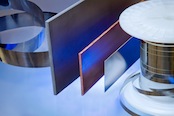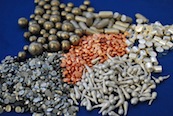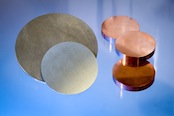Zinc Arsenide Zn3As2
MATERIAL SAFETY DATA SHEET
I. PRODUCT IDENTIFICATION
Manufacturer/Supplier:
ESPI Metals
1050 Benson Way, Ashland, OR 97520
Toll Free (800) 638-2581 * Fax (541) 488-8313
E-Mail: This email address is being protected from spambots. You need JavaScript enabled to view it.
Product Name: Zinc Arsenide
Formula: Zn3As2
CAS Number: 12006-40-5
II. HAZARDOUS INGREDIENTS
Hazardous Components: Zinc Arsenide
Percent (%): 0-100
OSHA/PEL: 0.01 mg/m3
ACGIH/TLV: 0.01 mg/m3
HMIS Rating:
Health: 3
Flammability: 0
Reactivity: 1
III. PHYSICAL DATA
Boiling Point: N/A
Melting Point: 1015 oC
Specific Gravity: 5.528 g/cc
Solubility in H2O: Insoluble
Appearance and Odor: Silver grey to black powder or pieces, no odor.
IV. FIRE AND EXPLOSION HAZARDS DATA
Flash Point: N/A
Autoignition Temperature: N/A
Flammable Limits: Upper: N/A Lower: N/A
Extinguishing Media: Use suitable extinguishing media for surrounding material and type of fire.
Special Fire Fighting Procedures: Wear a self-contained breathing apparatus and full protective clothing to prevent contact with skin and eyes. If without risk remove material from fire area.
Unusual Fire & Explosion Hazard: Material may emit toxic fumes of arsenic, arsenic oxides and zinc oxides if heated to decomposition.
V. HEALTH HAZARD INFORMATION
Effects of Exposure:
Zinc compounds have variable toxicity, but generally are of low toxicity. Zinc is not inherently a toxic element. However, when heated, it evolves a fume of zinc oxide which, when inhaled fresh, can cause a disease know as 'brass founders', 'ague', or 'brass chills'. Zinc oxide dust which is not freshly formed is virtually innocuous. There is no cumulative effect from the inhalation of zinc fumes.
Inorganic arsenic compounds are confirmed human carcinogens producing tumors of the mouth, esophagus, larynx, bladder, and para nasal sinus. A recognized carcinogen of the skin, lungs, and liver. Poisoning from arsenic compounds may be acute or chronic. Acute poisoning usually results from swallowing arsenic compounds, chronic poisoning from either swallowing or inhaling.
Acute Effects:
Inhalation: May cause irritation of mucous membranes and respiratory tract, metallic taste, pharyngitis, bloody nose, perforation of the nasal septum.
Ingestion: May cause marked irritation of the stomach and intestines with vomiting, diarrhea and nausea. In severe cases, the vomitus and stools are bloody and the victim goes into collapse and shock with weak, rapid pulse, cold sweats, coma and death.
Skin: May cause irritation.
Eye: May cause irritation.
Chronic Effects:
Inhalation: May cause loss of appetite, cramps, nausea, constipation, diarrhea, and damage to the liver, blood, kidneys and nervous system.
Ingestion: May cause loss of appetite, cramps, nausea, constipation, diarrhea, and damage to the liver, blood, kidneys and nervous system.
Skin: Can cause eczematous dermatitis, pigmentation, hyperkeratosis and cancerous skin changes.
Eye: None known.
Medical Conditions Generally Aggravated by Exposure: May aggravate any previous conditions.
Carcinogenicity: NTP: Yes IARC: Yes OSHA: Yes
EMERGENCY AND FIRST AID PROCEDURES:
INHALATION: Remove to fresh air. Keep warm and quiet. Give oxygen if breathing is difficult. Seek immediate medical attention.
INGESTION: Give 1-2 cups of milk or water and induce vomiting. Seek immediate medical attention. Never induce vomiting or give anything by mouth to an unconscious person.
SKIN: Remove contaminated clothing, flood skin with large amounts of water. Wash with mild soap and water. Seek medical attention if symptoms persist.
EYE: Immediately flush eyes, including under eyelids, with lukewarm water for at least 15 minutes. Seek medical attention.
VI. REACTIVITY DATA
Stability: Stable
Conditions to Avoid: Thermal decomposition
Incompatibility (Material to Avoid): Acids, oxidizers, halogens, interhalogens, and halocarbons.
Hazardous Decomposition Products: Zinc oxide and arsenic oxide fumes.
Hazardous Polymerization: Will not occur.
VII. SPILL OR LEAK PROCEDURES
Steps to Be Taken in Case Material Is Released or Spilled: Wear a self-contained breathing apparatus and full protective clothing. Isolate spill area and provide ventilation. Scoop up or vacuum up the spill using a high efficiency particulate absolute (HEPA) air filter and place in a container for proper disposal. Take care not to raise dust.
Waste Disposal Method: Dispose of in accordance with applicable Federal, State and Local regulations.
VIII. SPECIAL PROTECTION INFORMATION
Respiratory Protection: Wear NIOSH-approved full mask air purifying respirator.
Ventilation: Glove bag or box preferred. Use local exhaust to maintain concentration below PEL, TLV. General exhaust is not recommended.
Protective Gloves: Neoprene or rubber
Eye Protection: ANSI approved safety goggles
Other Protective Equipment: Lab coat and apron, flame and chemical resistant coveralls.
IX. SPECIAL PRECAUTIONS
Precautions to Be Taken in Handling and Storage: Store in tightly closed containers in a cool, dry, well-ventilated area away from acids and other incompatible materials. Wash hands and face throughly after handling and before eating. Arsenic is a poison.
Work Practices: Implement engineering and work practice controls to reduce and maintain concentration of exposure. Use good housekeeping and sanitation practices. Do not use tobacco or food in work area. Wash thoroughly before eating or smoking. Do not blow dust off clothing or skin with compressed air. Maintain eyewash capable of sustained flushing, safety drench shower and facilities for washing.
This product contains an arsenic and zinc compound which are subject to the reporting requirements of section 313 of the Emergency Planning and Community Right-to-Know Act of 1986 and 40CFR 372.
TSCA Listed: Yes
DOT Regulations:
Hazard Class: 6.1
Identification Number: UN1557
Packing Group: II
Proper Shipping Name: Arsenic compound, solid, n.o.s., (zinc arsenide)
The above information is believed to be correct, but does not purport to be all inclusive and shall be used only as a guide. ESPI shall not be held liable for any damage resulting from handling or from contact with the above product.
Issued By: S. Dierks
Revised/Verified: August 2011

 ALLOYS
ALLOYS 





